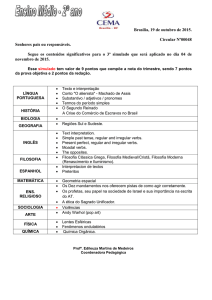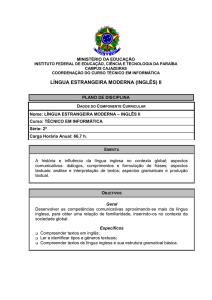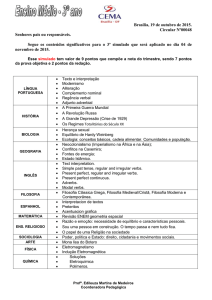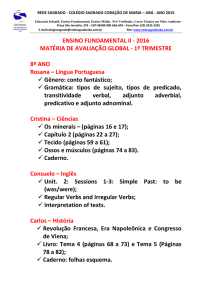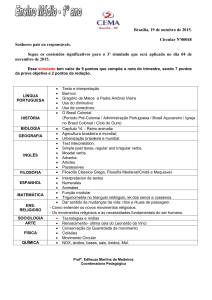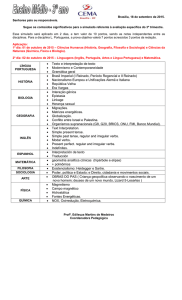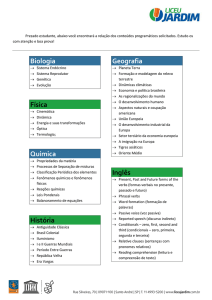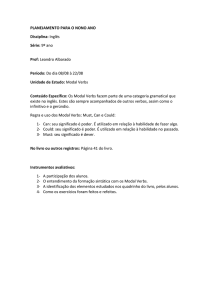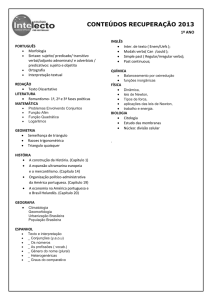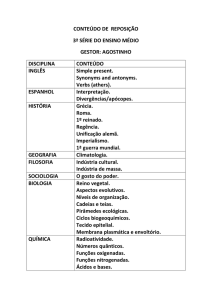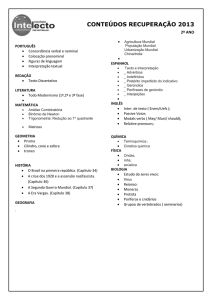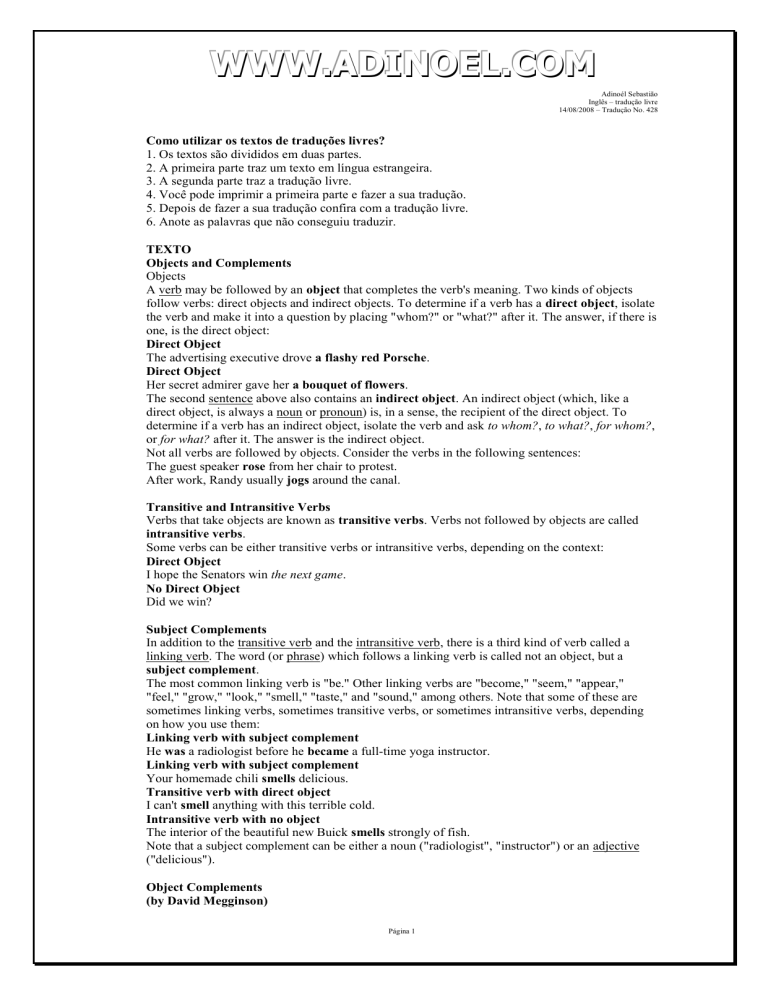
WWW.ADINOEL.COM
Adinoél Sebastião
Inglês – tradução livre
14/08/2008 – Tradução No. 428
Como utilizar os textos de traduções livres?
1. Os textos são divididos em duas partes.
2. A primeira parte traz um texto em língua estrangeira.
3. A segunda parte traz a tradução livre.
4. Você pode imprimir a primeira parte e fazer a sua tradução.
5. Depois de fazer a sua tradução confira com a tradução livre.
6. Anote as palavras que não conseguiu traduzir.
TEXTO
Objects and Complements
Objects
A verb may be followed by an object that completes the verb's meaning. Two kinds of objects
follow verbs: direct objects and indirect objects. To determine if a verb has a direct object, isolate
the verb and make it into a question by placing "whom?" or "what?" after it. The answer, if there is
one, is the direct object:
Direct Object
The advertising executive drove a flashy red Porsche.
Direct Object
Her secret admirer gave her a bouquet of flowers.
The second sentence above also contains an indirect object. An indirect object (which, like a
direct object, is always a noun or pronoun) is, in a sense, the recipient of the direct object. To
determine if a verb has an indirect object, isolate the verb and ask to whom?, to what?, for whom?,
or for what? after it. The answer is the indirect object.
Not all verbs are followed by objects. Consider the verbs in the following sentences:
The guest speaker rose from her chair to protest.
After work, Randy usually jogs around the canal.
Transitive and Intransitive Verbs
Verbs that take objects are known as transitive verbs. Verbs not followed by objects are called
intransitive verbs.
Some verbs can be either transitive verbs or intransitive verbs, depending on the context:
Direct Object
I hope the Senators win the next game.
No Direct Object
Did we win?
Subject Complements
In addition to the transitive verb and the intransitive verb, there is a third kind of verb called a
linking verb. The word (or phrase) which follows a linking verb is called not an object, but a
subject complement.
The most common linking verb is "be." Other linking verbs are "become," "seem," "appear,"
"feel," "grow," "look," "smell," "taste," and "sound," among others. Note that some of these are
sometimes linking verbs, sometimes transitive verbs, or sometimes intransitive verbs, depending
on how you use them:
Linking verb with subject complement
He was a radiologist before he became a full-time yoga instructor.
Linking verb with subject complement
Your homemade chili smells delicious.
Transitive verb with direct object
I can't smell anything with this terrible cold.
Intransitive verb with no object
The interior of the beautiful new Buick smells strongly of fish.
Note that a subject complement can be either a noun ("radiologist", "instructor") or an adjective
("delicious").
Object Complements
(by David Megginson)
Página 1
WWW.ADINOEL.COM
Adinoél Sebastião
Inglês – tradução livre
14/08/2008 – Tradução No. 428
An object complement is similar to a subject complement, except that (obviously) it modifies an
object rather than a subject. Consider this example of a subject complement:
The driver seems tired.
In this case, as explained above, the adjective "tired" modifies the noun "driver," which is the
subject of the sentence.
Sometimes, however, the noun will be the object, as in the following example:
I consider the driver tired.
In this case, the noun "driver" is the direct object of the verb "consider," but the adjective "tired" is
still acting as its complement.
In general, verbs which have to do with perceiving, judging, or changing something can cause
their direct objects to take an object complement:
Paint it black.
The judge ruled her out of order.
I saw the Prime Minister sleeping.
In every case, you could reconstruct the last part of the sentence into a sentence of its own using a
subject complement: "it is black," "she is out of order," "the Prime Minister is sleeping."
Written by Frances Peck
http://www.arts.uottawa.ca/writcent/hypergrammar/objcompl.html
Página 2
WWW.ADINOEL.COM
Adinoél Sebastião
Inglês – tradução livre
14/08/2008 – Tradução No. 428
TRADUÇÃO LIVRE No. 428
Objects and Complements
Objetos e Complementos
Objects
A verb may be followed by an object that
completes the verb's meaning. Two kinds of
objects follow verbs: direct objects and indirect
objects. To determine if a verb has a direct
object, isolate the verb and make it into a
question by placing "whom?" or "what?" after
it. The answer, if there is one, is the direct
object:
Objetos
Um verbo pode ser seguido por um objeto que
completa o sentido do verbo. Dois tipos de
objetos seguem os verbos: objetos direitos e
objetos indiretos. Para determinar se um verbo
tem um objeto direto, isole o verbo e construa
com ele uma questão usando
“whom? (=quem?)”
ou
“what? (=o quê?)”
após o verbo.
A resposta se houver uma, é o objeto direto.
Direct Object
The advertising executive drove a flashy red
Porsche.
Objeto Direto
O executivo de publicidade dirigiu um
cintilante Porsche vermelho.
Direct Object
Her secret admirer gave her a bouquet of
flowers.
Objeto Direto
Seu admirador secreto deu a ela um buquê de
flores.
The second sentence above also contains an
indirect object. An indirect object (which, like
a direct object, is always a noun or pronoun) is,
in a sense, the recipient of the direct object. To
determine if a verb has an indirect object,
isolate the verb and ask to whom?, to what?,
for whom?, or for what? after it. The answer is
the indirect object.
A segunda sentença acima também contém um
objeto indireto. Um objeto direto (o qual, como
um objeto direto, é sempre um substantivo ou
pronome) é, em um sentido, o receptor do
objeto direto. Para determinar se um verbo tem
um objeto indireto, isole o verbo e pergunte
“to whom? (=para quem?)”
“to what? (=para quê?)”
“for whom? (=por quem?)”
“for what? (=para quê)”
após o verbo.
A resposta é o objeto indireto.
Not all verbs are followed by objects. Consider
the verbs in the following sentences:
Nem todos os verbos são seguidos por objetos.
Considere os verbos nas sentenças seguintes:
The guest speaker rose from her chair to
protest.
O orador convidado levantou-se de sua cadeira
para protestar.
After work, Randy usually jogs around the
canal.
Após o trabalho, Randy usualmente corre em
torno do canal.
Transitive and Intransitive Verbs
Verbos Transitivos e Intransitivos
Verbs that take objects are known as transitive
verbs. Verbs not followed by objects are called
intransitive verbs.
Verbos que precisam de objetos são conhecidos
como verbos transitivos. Verbos não seguidos
por objetos são chamados verbos
Página 3
WWW.ADINOEL.COM
Adinoél Sebastião
Inglês – tradução livre
14/08/2008 – Tradução No. 428
intransitivos.
Some verbs can be either transitive verbs or
intransitive verbs, depending on the context:
Alguns verbos podem ser verbos transitivos ou
verbos intransitivos, dependendo do contexto:
Direct Object
I hope the Senators win the next game.
Objeto Direto
Eu espero que os “Senators” vençam o
próximo jogo.
No Direct Object
Did we win?
Não Objeto Direto
Nós vencemos?
Subject Complements
Complementos do Sujeito
In addition to the transitive verb and the
intransitive verb, there is a third kind of verb
called a linking verb. The word (or phrase)
which follows a linking verb is called not an
object, but a subject complement.
Em adição ao verbo transitivo e ao verbo
intransitivo, há um terceiro tipo do verbo
chamado verbo de ligação. A palavra (ou
frase) a qual segue um verbo de ligação é
chamada não como objeto, mas um
complemento do sujeito.
The most common linking verb is "be." Other
linking verbs are "become," "seem," "appear,"
"feel," "grow," "look," "smell," "taste," and
"sound," among others. Note that some of these
are sometimes linking verbs, sometimes
transitive verbs, or sometimes intransitive
verbs, depending on how you use them:
O verbo de ligação mais comum é “be” (=ser).
Outros verbos de ligação são
-“become” = tornar-se,
-“seem” = parecer,
-“appear” = parecer, aparecer, mostrar-se,
-“feel” = sentir,
-“grow” = crescer, aumentar, florescer,
-“look” = olhar, parecer,
-“smell” = perceber, cheirar, ter traços,
-“taste” = sentir o gosto, experimentar,
-“sound” = soar, retinir, ressoar.
Note que alguns desses são algumas vezes
verbos de ligação, algumas vezes verbos
transitivos, ou algumas vezes verbos
intransitivos, dependendo de como você usaos:
Linking verb with subject complement
He was a radiologist before he became a fulltime yoga instructor.
Verbo de ligação como complemento do
sujeito
Ele era um radiologista antes dele tornar-se
um instrutor de ioga em tempo integral.
Linking verb with subject complement
Your homemade chili smells delicious.
Verbo de ligação como complemento do
sujeito
Seu chili feito em casa cheira delicioso.
Transitive verb with direct object
I can't smell anything with this terrible cold.
Verbo transitivo como objeto direto
Eu não posso perceber coisa alguma com este
Página 4
WWW.ADINOEL.COM
Adinoél Sebastião
Inglês – tradução livre
14/08/2008 – Tradução No. 428
frio terrível.
Intransitive verb with no object
The interior of the beautiful new Buick smells
strongly of fish.
Verbo intransitivo como não objeto
O interior do bonito novo Buick tem traços de
peixe.
Note that a subject complement can be either a
noun ("radiologist", "instructor") or an
adjective ("delicious").
Note que um complemento do sujeito pode ser
um substantive (radiologista, instructor) ou um
adjetivo (delicioso).
Object Complements
(by David Megginson)
Complementos do Objeto
An object complement is similar to a subject
complement, except that (obviously) it
modifies an object rather than a subject.
Consider this example of a subject
complement:
Um complemento do objeto é parecido com
um complemento do sujeito, exceto que
(obviamente) ele modificar um objeto antes de
um sujeito. Considere este exemplo de um
complemento do sujeito:
The driver seems tired.
In this case, as explained above, the adjective
"tired" modifies the noun "driver," which is the
subject of the sentence.
O motorista parece cansado.
Neste caso, como explicado acima, o adjetivo
“tired” (=cansado) modifica o substantiva
“driver” (=motorista), o qual é o sujeito da
sentença.
Sometimes, however, the noun will be the
object, as in the following example:
I consider the driver tired.
In this case, the noun "driver" is the direct
object of the verb "consider," but the adjective
"tired" is still acting as its complement.
Algumas vezes, contudo, o substantive será o
objeto, como no seguinte exemplo:
Eu considero o motorista cansado.
Neste caso, o substantivo “driver” (=motorista)
é o objeto direto do verbo “consider”
(=considerar), mas o adjetivo “tired”
(=cansado) está, entretanto, atuando como seu
complemento.
In general, verbs which have to do with
perceiving, judging, or changing something can
cause their direct objects to take an object
complement:
Paint it black.
The judge ruled her out of order.
I saw the Prime Minister sleeping.
Em geral, verbos os quais tem que fazer
percepção, julgamento, ou mudança de alguma
coisa pode causar a seus objetos diretos
tornarem-se um complemento do objeto:
Pinte isto de preto.
O juiz a exclui da sentença.
Eu vi o Primeiro Ministro dormindo.
In every case, you could reconstruct the last
part of the sentence into a sentence of its own
using a subject complement: "it is black," "she
is out of order," "the Prime Minister is
sleeping."
Em todo caso, você pode reconstruir a última
parte da sentença dentro de própria sentença
usando um complemento do sujeito:
-“it is black” = isto é preto,
-“she is out of order” = ela está fora da
sentence,
-”the Prime Minister is sleeping” = o Primeiro
Ministro está dormindo.
Página 5

